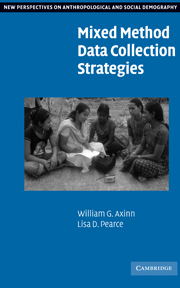Book contents
- Frontmatter
- Contents
- Acknowledgments
- Preface
- 1 Motivations for Mixed Method Social Research
- 2 Fitting Data Collection Methods to Research Aims
- 3 The Micro-Demographic Community Study Approach
- 4 Systematic Anomalous Case Analysis
- 5 Neighborhood History Calendars
- 6 Life History Calendars
- 7 Longitudinal Data Collection
- 8 Conclusion
- Notes
- Bibliography
- Index
5 - Neighborhood History Calendars
Published online by Cambridge University Press: 10 December 2009
- Frontmatter
- Contents
- Acknowledgments
- Preface
- 1 Motivations for Mixed Method Social Research
- 2 Fitting Data Collection Methods to Research Aims
- 3 The Micro-Demographic Community Study Approach
- 4 Systematic Anomalous Case Analysis
- 5 Neighborhood History Calendars
- 6 Life History Calendars
- 7 Longitudinal Data Collection
- 8 Conclusion
- Notes
- Bibliography
- Index
Summary
The previous chapters discussed mixed method approaches that integrate multiple methods, sequentially, into a single data collection strategy that has several separate steps. In this chapter and the next, we discuss a different type of mixed method approach, one that uses elements from several different methods to create a new, single hybrid method. The resulting hybrid methods have some characteristics of more structured methods, such as surveys, and other characteristics of less structured methods, such as unstructured interviewing or observation. Each specific combination that creates a new hybrid method is designed to achieve specific measurement goals, and each comes with its own strengths and weaknesses. In this chapter, we focus on Neighborhood History Calendar (NHC) methods as an example of such a hybrid method.
Both Neighborhood History Calendars and Life History Calendars, the subject of the next chapter, are designed to measure the timing and sequencing of changes occurring sometime in the past. The emphasis on measurement of timing is consistent with a strategy of studying causal relationships that focuses on the relative timing of various circumstances and events. As discussed in Chapter 1, our strategy for creating new empirical evidence to study cause and consequence in the social sciences relies heavily on the idea that the timing of measures should correspond to the timing implied in causal hypotheses. That is, if X causes Y, then X should precede Y in time, and our measure of X should specify timing well enough to know whether or not X preceded Y.
- Type
- Chapter
- Information
- Mixed Method Data Collection Strategies , pp. 103 - 137Publisher: Cambridge University PressPrint publication year: 2006



